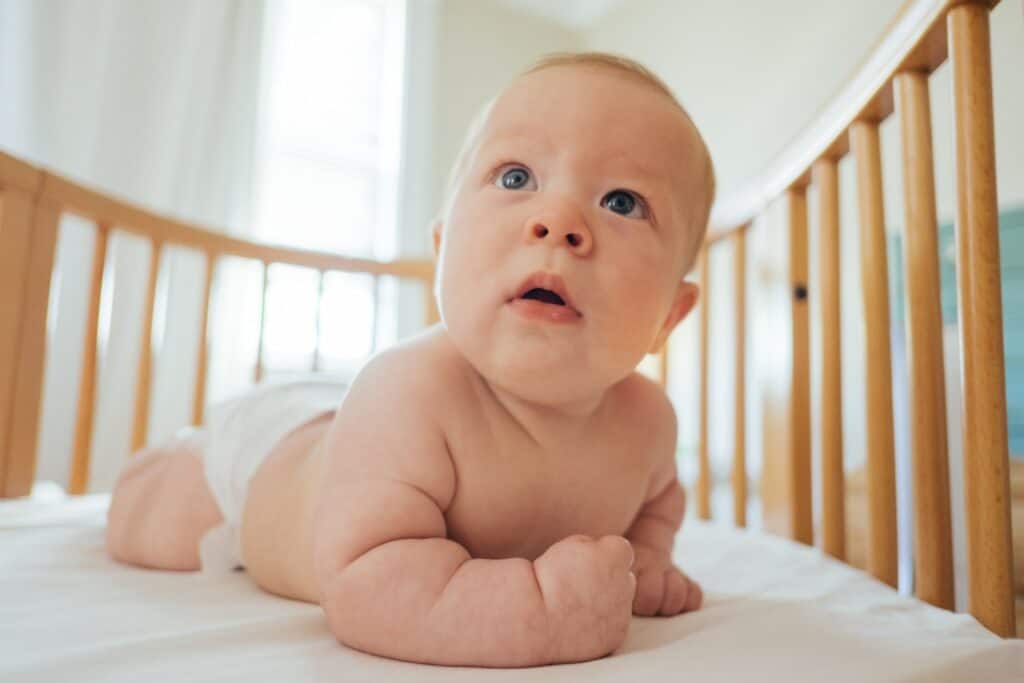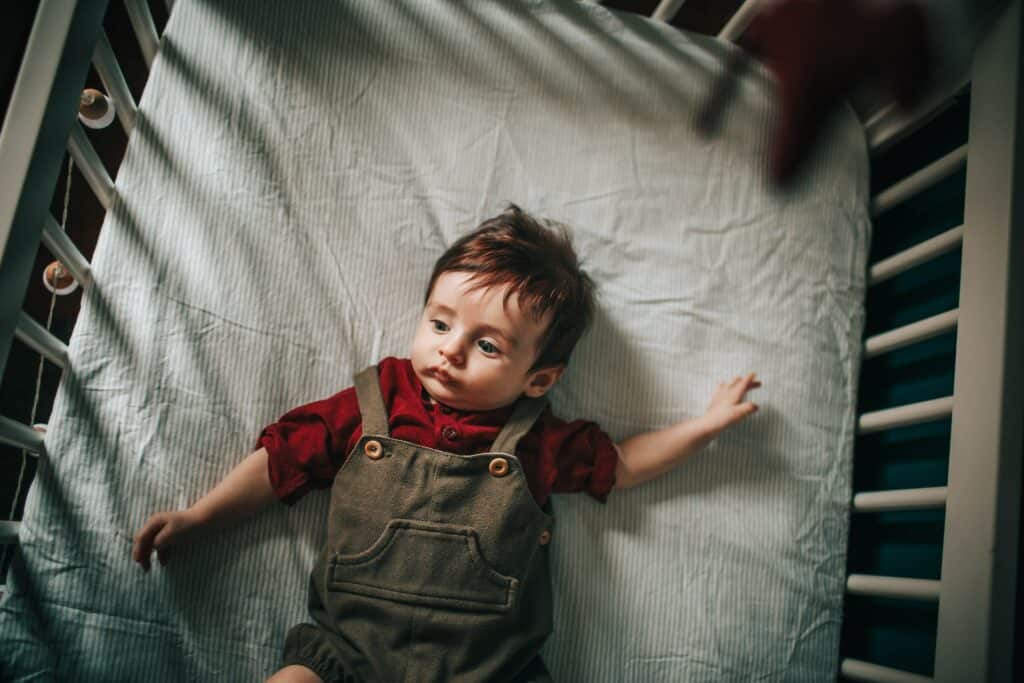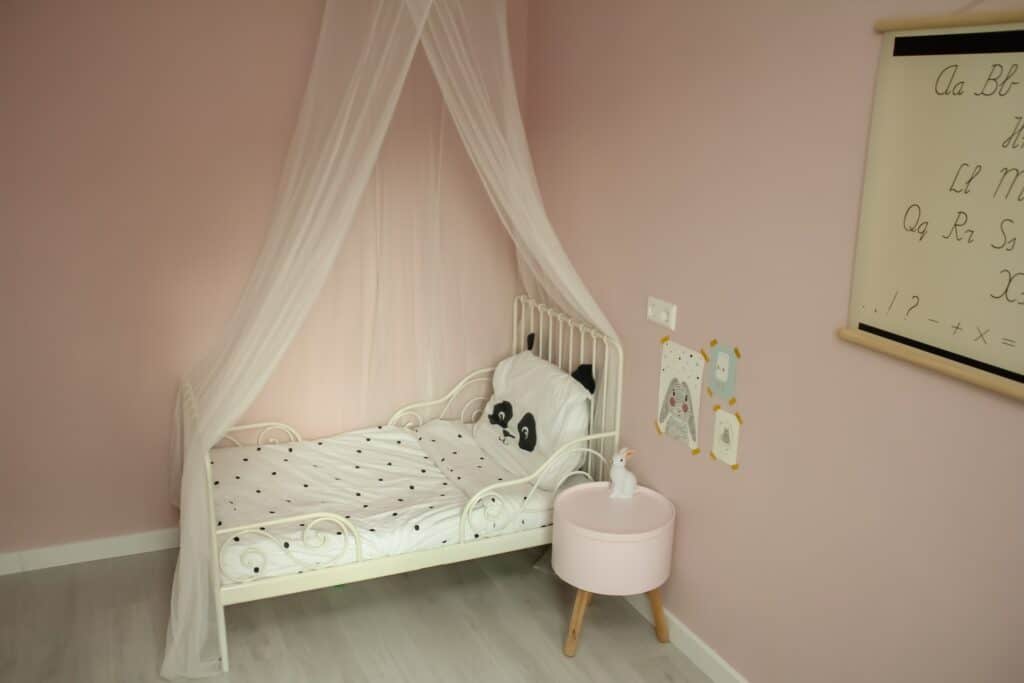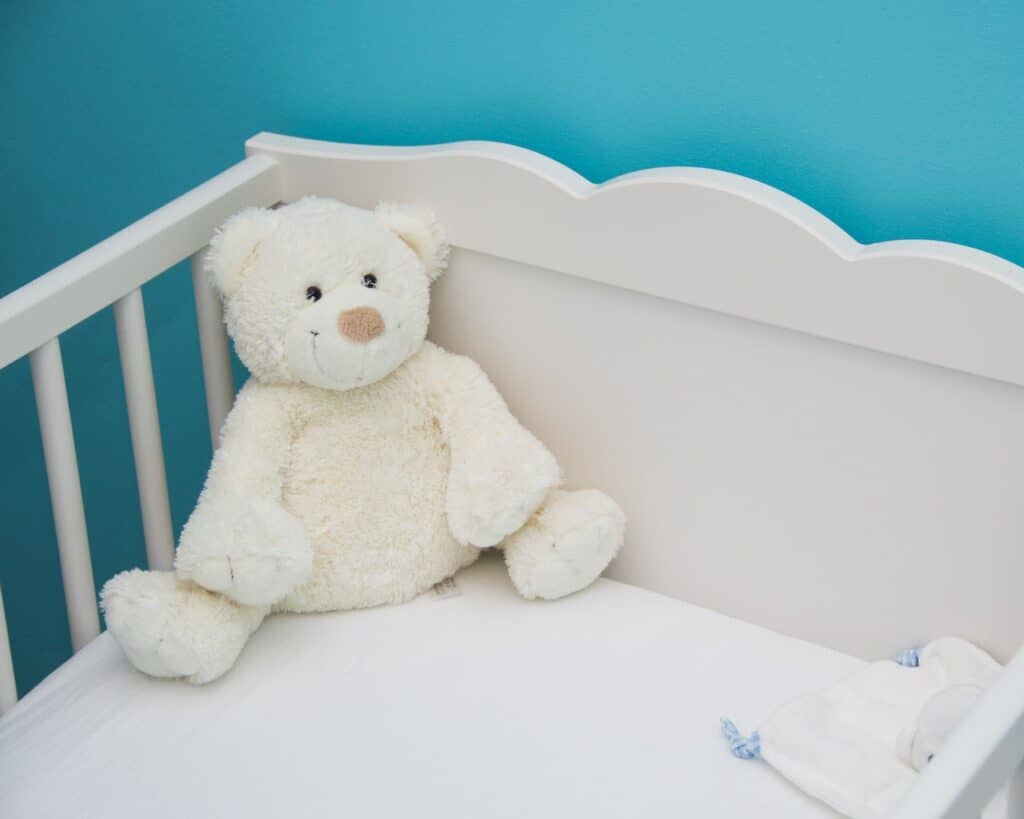Toddler beds are an essential part of a child’s transition from a crib to a bigger bed. They are designed to provide a safe and comfortable sleeping space for toddlers who are too big for a crib but not yet ready for a twin or full-sized bed. But what size is a toddler bed, and how does it compare to a crib or a regular bed?
Understanding toddler beds is important for parents who are looking to make the transition from a crib to a toddler bed. Toddler beds are typically smaller than twin or full-sized beds but larger than cribs. They are designed to be low to the ground to prevent falls and have safety rails on both sides to keep toddlers from rolling out of bed. Toddler beds come in a variety of styles and colors, making it easy to find one that matches your child’s personality and bedroom decor.
Key Takeaways
- Toddler beds are designed for children who have outgrown their cribs but are not yet ready for a twin or full-sized bed.
- Toddler beds are typically smaller than twin or full-sized beds but larger than cribs, with safety rails on both sides to prevent falls.
- Toddler beds come in a variety of styles and colors, making it easy to find one that matches your child’s personality and bedroom decor.
Understanding Toddler Beds
Toddler beds are designed for children who have outgrown their cribs but are not yet ready for a full-sized bed. They are typically smaller than twin beds and are designed to be low to the ground to make it easier for toddlers to get in and out of bed.

When it comes to size, toddler beds are generally 70-80 cm wide and 140-150 cm long. This makes them slightly smaller than a twin bed, which is typically 99 cm wide and 190 cm long.
Toddler beds are usually made of sturdy materials such as wood or metal to ensure that they can withstand the wear and tear of young children. They are also designed to be comfortable, with features such as padded headboards and footboards.
When choosing a toddler bed, it’s important to consider factors such as safety, comfort, and durability. Look for a bed that meets safety standards and has features such as guardrails to prevent falls.
Overall, toddler beds are a great option for parents who want to transition their child from a crib to a larger bed. They provide a comfortable and safe sleeping space for young children and are available in a wide range of styles and designs to suit any taste.
Standard Toddler Bed Dimensions
When it comes to choosing a toddler bed, one of the most important things to consider is the size. Standard toddler beds are designed to be smaller than twin beds, but larger than cribs, to provide a comfortable and safe sleeping space for young children.
The dimensions of a standard toddler bed are typically around 52 inches long and 28 inches wide. This size is designed to accommodate a standard crib mattress, which is usually around 28 inches wide and 52 inches long.
It’s important to note that while these are the standard dimensions for toddler beds, there can be some variation between different brands and models. Some toddler beds may be slightly larger or smaller, so it’s always a good idea to check the specific dimensions of any bed you’re considering before making a purchase.
In addition to the overall size of the bed, it’s also important to consider the height of the bed. Most toddler beds are designed to be lower to the ground than standard twin beds, to make it easier for young children to climb in and out of bed safely.
Overall, when looking for a toddler bed, it’s important to choose a size that will provide a comfortable and safe sleeping space for your child, while also fitting well in the room where it will be used.
Comparing Toddler Beds and Cribs
When it comes to transitioning from a crib to a toddler bed, parents often wonder what size is a toddler bed and how it compares to a crib. In general, a toddler bed is smaller than a standard crib but larger than a mini crib.
A standard crib typically measures around 28 inches by 52 inches, while a toddler bed is usually around 27 inches by 52 inches. This means that a toddler bed is slightly narrower than a standard crib, but the same length.
A convertible crib, which can be transformed into a toddler bed, is usually the same size as a standard crib. This means that when converted into a toddler bed, it will be larger than a regular toddler bed.
Mini cribs, on the other hand, are smaller than both standard cribs and toddler beds. They usually measure around 24 inches by 38 inches, making them a good option for parents with limited space. However, it’s important to note that mini cribs are not recommended for long-term use as they may not provide enough space for a growing child.
When it comes to mattress size, a toddler bed typically uses the same size mattress as a crib. However, some toddler beds may require a slightly larger mattress. It’s important to check the manufacturer’s specifications before purchasing a mattress for a toddler bed.
Overall, parents should consider their child’s age, size, and sleeping habits when deciding whether to transition to a toddler bed. While a toddler bed may be a good option for some children, others may be better suited to staying in a crib for a little longer.
Toddler Bed Mattress Sizes
When it comes to purchasing a toddler bed, one of the most important things to consider is the size of the mattress. A toddler bed is designed to accommodate a specific mattress size, and using the wrong size can lead to discomfort for your child and potential safety hazards. In this section, we will discuss the most common toddler bed mattress sizes and what you should look for when selecting a mattress.

Crib Mattress Size
Many toddler beds are designed to use the same size mattress as a standard crib. A crib mattress typically measures 28 inches by 52 inches, and is usually 5-6 inches thick. If you already have a crib mattress, it may be possible to use it in your toddler bed. However, it’s important to ensure that the mattress fits snugly in the bed frame and that there are no gaps between the mattress and the bed rails.
Toddler Mattress Size
Some toddler beds require a specific mattress size that is slightly larger than a crib mattress. These mattresses typically measure 27 inches by 52 inches, and are also 5-6 inches thick. It’s important to check the manufacturer’s specifications for your toddler bed to determine the appropriate mattress size.
Foam Mattresses
Many toddler mattresses are made of foam, which can be a great option for parents who are looking for an affordable and lightweight mattress. Foam mattresses come in a variety of thicknesses, ranging from 3 inches to 6 inches. Thicker mattresses may provide more support and comfort for your child, but they may also be more difficult to move and store.
Mattress Thickness
When selecting a toddler mattress, it’s important to consider the thickness of the mattress. A thicker mattress may provide more support and comfort for your child, but it may also be more difficult to move and store. Thinner mattresses may be more lightweight and easier to move, but they may not provide as much support for your child.
In conclusion, selecting the right size and type of mattress for your toddler bed is an important decision. By considering factors such as mattress size, thickness, and material, you can ensure that your child has a comfortable and safe sleeping environment.
Safety Features of Toddler Beds
When it comes to toddler beds, safety is of utmost importance. Parents want to ensure that their little ones are secure and comfortable while sleeping. Here are some safety features to look for when choosing a toddler bed:
1. Guardrails
One of the most important safety features of a toddler bed is guardrails. These rails prevent children from rolling out of bed and getting injured. Toddler beds should have guardrails on both sides of the bed, and they should be at least five inches high.
2. Toddler Bed Rails
In addition to guardrails, some toddler beds come with toddler bed rails that can be attached to the bed frame. These rails provide extra security and can be especially helpful for children who move around a lot in their sleep.
3. Low to the Ground
Toddler beds should be low to the ground to prevent injuries from falls. A bed that is too high can make it difficult for a child to get in and out of bed safely.
4. Sturdy Construction
When choosing a toddler bed, it is important to look for one that is made of sturdy materials and has a solid construction. This will ensure that the bed is stable and can withstand the weight of a child.
5. Certifications
Look for toddler beds that have been certified by safety organizations such as the Juvenile Products Manufacturers Association (JPMA) or the Consumer Product Safety Commission (CPSC). These certifications ensure that the bed has been tested and meets safety standards.
Overall, when it comes to toddler bed safety, it is important to choose a bed that has guardrails, is low to the ground, has a sturdy construction, and has been certified by safety organizations. By choosing a safe toddler bed, parents can rest assured that their little ones are sleeping soundly and securely.
Transitioning from Crib to Toddler Bed
When it’s time to transition your child from a crib to a toddler bed, there are a few things to keep in mind to make the process as smooth as possible. One of the most important factors is timing.

Most children are ready to make the move to a toddler bed sometime between 18 months and 3 years of age. However, every child is different, so it’s important to watch for signs that your child is ready to make the transition. These signs might include climbing out of the crib, showing interest in “big kid” beds, or simply outgrowing the crib.
Another important factor to consider is the bedtime routine. It’s a good idea to stick to the same routine as much as possible during the transition to help your child feel secure and comfortable. This might include reading a story, singing a song, or giving a favorite stuffed animal a goodnight hug.
If you have a convertible crib, you may be able to simply remove one side to turn it into a toddler bed. This can be a great option, as it allows your child to stay in a familiar sleeping space while making the transition to a new type of bed. However, if you don’t have a convertible crib, there are plenty of toddler beds available on the market.
Toddler beds are designed to be low to the ground, making it easy for your child to get in and out of bed on their own. They also typically come with safety rails to help prevent falls during the night.
Overall, the transition from crib to toddler bed can be a big step for both you and your child. By keeping timing, bedtime routine, and bed options in mind, you can help make the process as smooth and stress-free as possible.
Other Bed Options for Toddlers
While a toddler bed may be the most popular option for parents with young children, there are other bed options that can be considered. Here are a few alternatives to toddler beds that parents may want to consider:
1. Twin Beds
Twin beds are a popular option for parents who want to transition their child from a crib to a larger bed. These beds are the same size as a standard adult twin bed, but they are lower to the ground, making them easier for toddlers to climb in and out of. Twin beds also offer more space for children to grow into, which means parents won’t have to replace the bed as quickly as they would with a toddler bed.
2. Bunk Beds and Loft Beds
For parents with multiple children or limited space, bunk beds and loft beds can be a great option. Bunk beds are two beds stacked on top of each other, while loft beds are elevated beds with a play area or additional storage space underneath. Both options can be fun for kids and can help maximize the available space in a room.
3. Floor Beds
Floor beds are exactly what they sound like – beds that are placed directly on the floor. While this option may not be for everyone, some parents prefer floor beds because they are low to the ground and can help prevent injuries if a child falls out of bed. Floor beds can also be a good option for families who co-sleep or practice Montessori-style parenting.
4. Trundle Beds
Trundle beds are a type of bed that have a second bed hidden underneath the main bed. This option can be great for sleepovers or for families with multiple children who share a room. When not in use, the second bed can be pushed back under the main bed, saving space in the room.
Overall, there are many bed options available for parents with toddlers. It’s important to consider the needs of the child and the family when choosing a bed, as well as the available space in the room. By exploring different options, parents can find the perfect bed for their growing child.
Choosing the Right Toddler Bed
When it comes to choosing the right toddler bed, there are several factors to consider. The bed should provide support and have a sturdy frame to ensure the safety of the child. Additionally, assembly instructions should be clear and easy to follow to make the process stress-free for parents. Finally, the bed should fit within the family’s budget.

Support is crucial when it comes to choosing a toddler bed. The bed should be able to support the weight of the child and any additional weight from bedding or toys. A bed with a solid base and sturdy frame is ideal. It’s essential to ensure that the bed is not wobbly or unstable, as this could pose a safety risk for the child.
Assembly instructions should be clear and easy to follow. Parents should be able to assemble the bed without any difficulty. The instructions should be included with the bed and should be easy to understand. If the instructions are unclear or difficult to follow, it could lead to frustration and a poorly assembled bed.
Budget is another important factor to consider when choosing a toddler bed. There are many options available in various price ranges. It’s important to find a bed that fits within the family’s budget while still providing the necessary support and safety features.
In conclusion, when choosing a toddler bed, it’s important to consider the support, sturdy frame, assembly instructions, and budget. By keeping these factors in mind, parents can find a bed that is safe, comfortable, and within their budget.
Also, read: Mini Crib Weight Limit
Frequently Asked Questions
What is the standard size for a toddler bed frame?
The standard size for a toddler bed frame is typically 52 inches in length and 28 inches in width. However, it’s important to note that there may be variations in size depending on the brand and model.
What size mattress fits a toddler bed?
A toddler bed usually requires a mattress that is 27 inches in width and 52 inches in length. It’s important to ensure that the mattress fits snugly and securely within the bed frame to prevent any safety hazards.
When should a child transition from a toddler bed to a twin bed?
The ideal time to transition a child from a toddler bed to a twin bed is around the age of 3 or 4 years old. However, this can vary depending on the child’s size and development. It’s important to monitor the child’s comfort and safety in the toddler bed and make the transition when necessary.
Is a toddler bed the same size as a crib?
No, a toddler bed is slightly larger than a crib. While a standard crib mattress measures 28 inches in width by 52 inches in length, a toddler bed frame typically measures 52 inches in length and 28 inches in width.
What is the age limit for a toddler bed?
There is no set age limit for a toddler bed, as it largely depends on the child’s size and development. However, most children outgrow their toddler bed by the age of 5 or 6 years old.
How much smaller is a toddler bed compared to a twin bed?
A toddler bed is significantly smaller than a twin bed. While a toddler bed measures 52 inches in length and 28 inches in width, a twin bed measures 75 inches in length and 38 inches in width.

Iesha is a loving mother of 2 beautiful children. She’s an active parent who enjoys indoor and outdoor adventures with her family. Her mission is to share practical and realistic parenting advice to help the parenting community becoming stronger.
